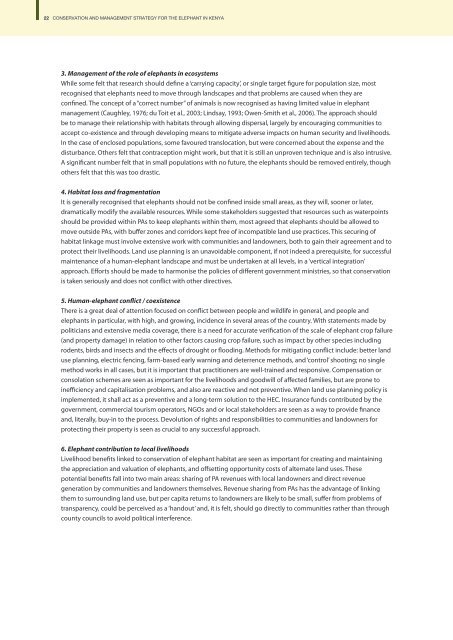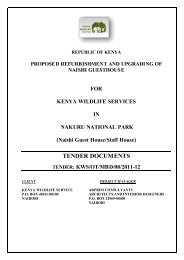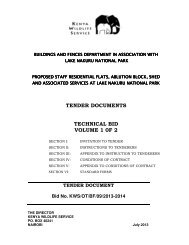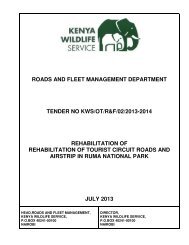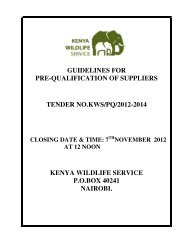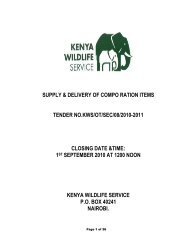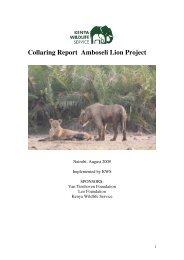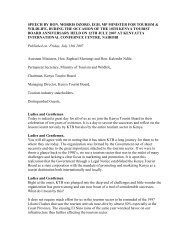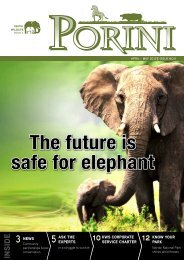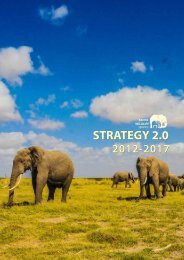Conservation and Management Strategy for the Elephant in Kenya
Conservation and Management Strategy for the Elephant in Kenya
Conservation and Management Strategy for the Elephant in Kenya
Create successful ePaper yourself
Turn your PDF publications into a flip-book with our unique Google optimized e-Paper software.
22 CONSERVATION AND MANAGEMENT STRATEGY FOR THE ELEPHANT IN KENYA<br />
3. <strong>Management</strong> of <strong>the</strong> role of elephants <strong>in</strong> ecosystems<br />
While some felt that research should def<strong>in</strong>e a ‘carry<strong>in</strong>g capacity’, or s<strong>in</strong>gle target figure <strong>for</strong> population size, most<br />
recognised that elephants need to move through l<strong>and</strong>scapes <strong>and</strong> that problems are caused when <strong>the</strong>y are<br />
conf<strong>in</strong>ed. The concept of a “correct number” of animals is now recognised as hav<strong>in</strong>g limited value <strong>in</strong> elephant<br />
management (Caughley, 1976; du Toit et al., 2003; L<strong>in</strong>dsay, 1993; Owen-Smith et al., 2006). The approach should<br />
be to manage <strong>the</strong>ir relationship with habitats through allow<strong>in</strong>g dispersal, largely by encourag<strong>in</strong>g communities to<br />
accept co-existence <strong>and</strong> through develop<strong>in</strong>g means to mitigate adverse impacts on human security <strong>and</strong> livelihoods.<br />
In <strong>the</strong> case of enclosed populations, some favoured translocation, but were concerned about <strong>the</strong> expense <strong>and</strong> <strong>the</strong><br />
disturbance. O<strong>the</strong>rs felt that contraception might work, but that it is still an unproven technique <strong>and</strong> is also <strong>in</strong>trusive.<br />
A significant number felt that <strong>in</strong> small populations with no future, <strong>the</strong> elephants should be removed entirely, though<br />
o<strong>the</strong>rs felt that this was too drastic.<br />
4. Habitat loss <strong>and</strong> fragmentation<br />
It is generally recognised that elephants should not be conf<strong>in</strong>ed <strong>in</strong>side small areas, as <strong>the</strong>y will, sooner or later,<br />
dramatically modify <strong>the</strong> available resources. While some stakeholders suggested that resources such as waterpo<strong>in</strong>ts<br />
should be provided with<strong>in</strong> PAs to keep elephants with<strong>in</strong> <strong>the</strong>m, most agreed that elephants should be allowed to<br />
move outside PAs, with buffer zones <strong>and</strong> corridors kept free of <strong>in</strong>compatible l<strong>and</strong> use practices. This secur<strong>in</strong>g of<br />
habitat l<strong>in</strong>kage must <strong>in</strong>volve extensive work with communities <strong>and</strong> l<strong>and</strong>owners, both to ga<strong>in</strong> <strong>the</strong>ir agreement <strong>and</strong> to<br />
protect <strong>the</strong>ir livelihoods. L<strong>and</strong> use plann<strong>in</strong>g is an unavoidable component, if not <strong>in</strong>deed a prerequisite, <strong>for</strong> successful<br />
ma<strong>in</strong>tenance of a human-elephant l<strong>and</strong>scape <strong>and</strong> must be undertaken at all levels, <strong>in</strong> a ‘vertical <strong>in</strong>tegration’<br />
approach. Ef<strong>for</strong>ts should be made to harmonise <strong>the</strong> policies of different government m<strong>in</strong>istries, so that conservation<br />
is taken seriously <strong>and</strong> does not conflict with o<strong>the</strong>r directives.<br />
5. Human-elephant conflict / coexistence<br />
There is a great deal of attention focused on conflict between people <strong>and</strong> wildlife <strong>in</strong> general, <strong>and</strong> people <strong>and</strong><br />
elephants <strong>in</strong> particular, with high, <strong>and</strong> grow<strong>in</strong>g, <strong>in</strong>cidence <strong>in</strong> several areas of <strong>the</strong> country. With statements made by<br />
politicians <strong>and</strong> extensive media coverage, <strong>the</strong>re is a need <strong>for</strong> accurate verification of <strong>the</strong> scale of elephant crop failure<br />
(<strong>and</strong> property damage) <strong>in</strong> relation to o<strong>the</strong>r factors caus<strong>in</strong>g crop failure, such as impact by o<strong>the</strong>r species <strong>in</strong>clud<strong>in</strong>g<br />
rodents, birds <strong>and</strong> <strong>in</strong>sects <strong>and</strong> <strong>the</strong> effects of drought or flood<strong>in</strong>g. Methods <strong>for</strong> mitigat<strong>in</strong>g conflict <strong>in</strong>clude: better l<strong>and</strong><br />
use plann<strong>in</strong>g, electric fenc<strong>in</strong>g, farm-based early warn<strong>in</strong>g <strong>and</strong> deterrence methods, <strong>and</strong> ‘control’ shoot<strong>in</strong>g; no s<strong>in</strong>gle<br />
method works <strong>in</strong> all cases, but it is important that practitioners are well-tra<strong>in</strong>ed <strong>and</strong> responsive. Compensation or<br />
consolation schemes are seen as important <strong>for</strong> <strong>the</strong> livelihoods <strong>and</strong> goodwill of affected families, but are prone to<br />
<strong>in</strong>efficiency <strong>and</strong> capitalisation problems, <strong>and</strong> also are reactive <strong>and</strong> not preventive. When l<strong>and</strong> use plann<strong>in</strong>g policy is<br />
implemented, it shall act as a preventive <strong>and</strong> a long-term solution to <strong>the</strong> HEC. Insurance funds contributed by <strong>the</strong><br />
government, commercial tourism operators, NGOs <strong>and</strong> or local stakeholders are seen as a way to provide f<strong>in</strong>ance<br />
<strong>and</strong>, literally, buy-<strong>in</strong> to <strong>the</strong> process. Devolution of rights <strong>and</strong> responsibilities to communities <strong>and</strong> l<strong>and</strong>owners <strong>for</strong><br />
protect<strong>in</strong>g <strong>the</strong>ir property is seen as crucial to any successful approach.<br />
6. <strong>Elephant</strong> contribution to local livelihoods<br />
Livelihood benefits l<strong>in</strong>ked to conservation of elephant habitat are seen as important <strong>for</strong> creat<strong>in</strong>g <strong>and</strong> ma<strong>in</strong>ta<strong>in</strong><strong>in</strong>g<br />
<strong>the</strong> appreciation <strong>and</strong> valuation of elephants, <strong>and</strong> offsett<strong>in</strong>g opportunity costs of alternate l<strong>and</strong> uses. These<br />
potential benefits fall <strong>in</strong>to two ma<strong>in</strong> areas: shar<strong>in</strong>g of PA revenues with local l<strong>and</strong>owners <strong>and</strong> direct revenue<br />
generation by communities <strong>and</strong> l<strong>and</strong>owners <strong>the</strong>mselves. Revenue shar<strong>in</strong>g from PAs has <strong>the</strong> advantage of l<strong>in</strong>k<strong>in</strong>g<br />
<strong>the</strong>m to surround<strong>in</strong>g l<strong>and</strong> use, but per capita returns to l<strong>and</strong>owners are likely to be small, suffer from problems of<br />
transparency, could be perceived as a ‘h<strong>and</strong>out’ <strong>and</strong>, it is felt, should go directly to communities ra<strong>the</strong>r than through<br />
county councils to avoid political <strong>in</strong>terference.


